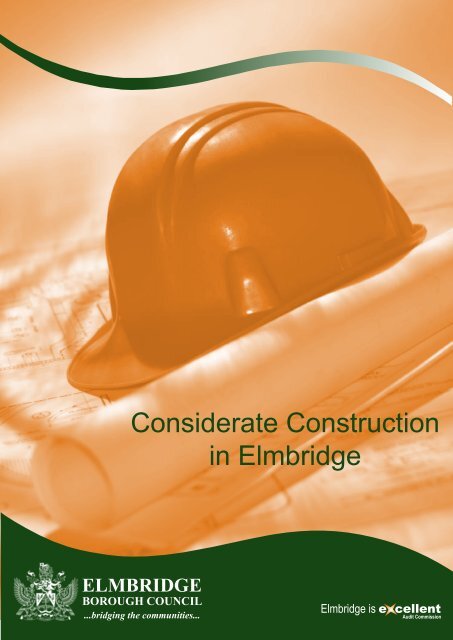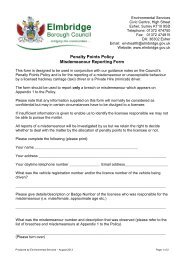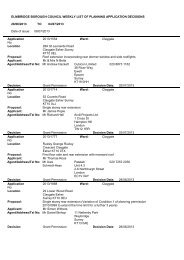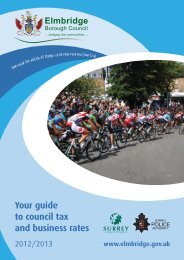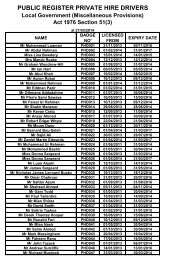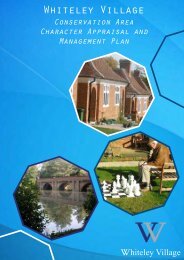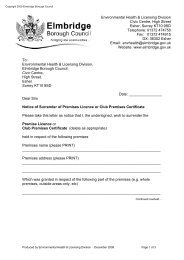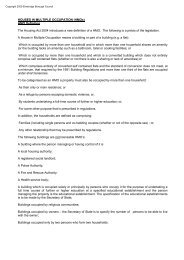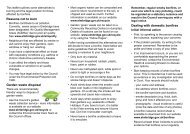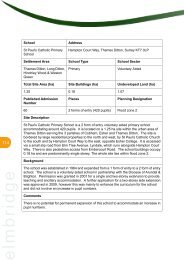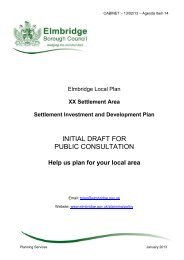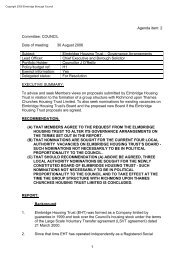Considerate Construction Booklet (2).pdf - Elmbridge Borough Council
Considerate Construction Booklet (2).pdf - Elmbridge Borough Council
Considerate Construction Booklet (2).pdf - Elmbridge Borough Council
- No tags were found...
You also want an ePaper? Increase the reach of your titles
YUMPU automatically turns print PDFs into web optimized ePapers that Google loves.
nov 05 31.10.2005 9:21 Page 111. tölublað • 10. árgangur Heilsa ehf, Sundaborg 1, 104 Reykjavík • Sími 533 3232 • www.heilsa.is • nóvember 2005NÝTTHollur hádegisverður í HeilsuhúsinuAlla virka daga verður hægt að fá sér bráðhollanbita í hádeginu í framantöldumverslunum Heilsuhússins. Heilsuhúsið hefurí samstarfi við Yndisauka hafið sölu á matarmiklumsalötum, samlokum og nokkrumtegundum ídýfa. Vart þarf að taka fram aðhér er um fyrsta flokks hráefni að ræða ogengin aukaefni er hægt að finna í matnum.Maturinn er nýr og ferskur og ætti aðseðja hungur þeirra sem leggja leið sína íHeilsuhúsið að fá sér heilsusamlegan ognæringarríkan mat til að geta tekist á viðamstur dagsins. Á boðstólum verða m.a.Nú er hægtað fá sér hollan hádegisverðí Heilsuhúsinu í Kringlunni,á Smáratorgi og á Skólavörðustígnumnokkrar tegundir af tilbúnum salötum, t.d.með grilluðu grænmeti (eggaldin, paprika,aspas, tómatar) og fyrsta flokks grænt salat.Einnig er hægt að velja um spelt pasta,salat með furuhnetum, pistasíum og salatmeð kjúkling.Hummus og linsubaunamauk, eru líka áboðstólum svo eitthvað sé nefnt. Eins ogöllum ætti að vera kunnugt er aðalsmerkiHeilsuhússins hollusta, gæði og gott bragðog hádegissalatið mun engan svíkja!Verði ykkur að góðu!Nammi, nammNú er fáanlegt í Heilsuhúsinu ný tegundaf sælgæti frá þýska fyrirtækinu Rosengarten.Það sem er sérstakt við þessa vöruer að hún er eingöngu unnin úr fyrstaflokks lífrænt ræktuðu hráefni. Enginhvítur sykur og engin aukaefni. Þetta erunokkrar tegundir eins og spelt vöfflurmeð súkkulaði húð,Eplaskífur með dökku og ljósu súkkulaði,Romm ananas í dökkusúkkulaði,Kanil súkkulaði möndlur svo fátt eitt sénefnt. Þessa vöru er hægt að kaupa ílausu úr snakkboxunum okkar eða uppvigtaðaí litlum pokum.Lækning fyrir þá sem þjást af gigtarverkjum í hnjám?Fyrstu niðurstöður úr tveimur stórumrannsóknum á glucosamine ogchondroitin sýndu fram á að þau erumjö hjálpleg gigtarsjúklingum og léttuverki þeirra verulega. Að rannsókninnistóðu nokkur hagsmunasamtök gigtarsjúklingaog þeirra sem vildu sjá hvaða á-hrif glucosamine/chonodroitin hefðu ágigtveika. 1500 gigtarsjúklingar sögðu aðglucosamine-chondroitin-blandan ásamtlyfsseðilsskylda lyfinu celecoxib hefðu verulegadregið úr verkjum í hnjám þegar þeirbáru saman árangurinn við lyfleysu sem þeirhöfðu fengið áður. Stofnunin sem sá umsamanburð á lyfjatöku og árangri, komst aðþeirri niðurstöðu að glucosamine sulfate væriáhrifaríkara en acetaminophen og ályktaði þvísvo að „glucosamine sulfate gæti verið helsta ogbesta meðalið fyrir þá sem eiga við gigt í hnjámað stríða.“Heilsuhúsið á Selfossi!Nú hefur Heilsuhúsið opnað á Selfossi ogbýður Selfyssinga sem og aðra íbúa Árborgarsvæðisins(og auðvitað þá sem eigaleið um!) hjartanlega velkomna í hóp á-nægðra viðskiptavina Heilsuhússins. Vöruúrvaliðverður að sjálfsögðu það sama ogí öðrum útibúum Heilsuhússins, sem ogafsláttardagar og tilboð. Heilsuhúsið verðurað finna á Austurvegi 44 þar sem áðurvar heilsubúð Árnessapóteks og er KristínFriðriksdóttir verslunarstjóri. Opnunartímarverða sem hér segir: Alla virka daga frákl. 9-18.30 og á laugardögum kl. 10 -14.Við hlökkum til að sjá ykkur!
IndexIntroduction .............................................................................................. 3Demolition................................................................................................. 3Noise and Vibration................................................................................. 4Nuisance from Smoke and Fumes ....................................................... 5Protection of Trees ................................................................................. 6Control of Environmental Hazards and Waste.................................... 6Contaminated Land ......................................................................... 7Asbestos and other Hazardous Materials ................................... 7Waste Management ......................................................................... 7Effects of Traffic and Parking ................................................................ 8Site Traffic ......................................................................................... 8Roads and Footways ....................................................................... 9Mud on the Road .............................................................................. 9Protection of Pedestrians and Road Users ................................. 10General .............................................................................................. 10Graffiti and Fly Posting ........................................................................... 10Further Information ................................................................................. 11Useful Contacts ........................................................................................ 112
IntroductionThe purpose of this leaflet is to help building contractors and others involved in development workin the <strong>Borough</strong> to carry out their operations in a safe and considerate manner. Also, to have dueregard for, and cause minimal disturbance to, local residents and businesses, passing pedestriansand road users. By following this advice, contractors will know what is expected of them and whereto go to get further advice and help.In appropriate situations this leaflet will be referred to in ‘an informative’ added to planningpermissions granted by the <strong>Council</strong> allowing developers to discuss with the <strong>Council</strong> proposedworking methods that are tailored to their specific development. It should be read in addition to anyspecific conditions imposed in the planning permission dealing with matters such as treeprotection, on-site storage of materials and parking, method of construction statement etc.Developers should ensure that their contractors are fully aware of the contents of this leaflet, furthercopies are available from the <strong>Council</strong>’s Environmental Health Division – see 'Useful Contacts' onpage 11.For larger operations, contact names and numbers of appropriate site personnel, including a 24-hour emergency call out number, should be forwarded to the Environmental Health Division at theearliest opportunity. We also advise you to appoint a responsible person to liase with the <strong>Council</strong>,local residents, business organisations and other authorities, and keep them informed on matterslikely to affect them. Good relations can be developed by keeping people informed of progress andby treating complaints fairly and rapidly. At the earliest opportunity, neighbours should be informedof:• The start date of site works;• The nature and duration of the project;• The main stages of the project; and• Contact names and numbers of appropriate site personnel.The Environmental Health Division should be told in advance when any unusual activities includingout-of-hours working are planned, and always where their approval is required.DemolitionThe Building Act 1984 requires a person intending to demolish abuilding to give the <strong>Council</strong> notice of the demolition. Demolition workcannot be commenced until either the <strong>Council</strong> has served a counternotice or six weeks have passed since the original notice was served.Counter notices may impose conditions appropriate to the scale ofdemolition. Notifications should be sent to the Building ControlDivision (see useful contacts). A demolition notification form isavailable from <strong>Elmbridge</strong>’s website at www.elmbridge.gov.uk, in the‘A-Z’, under ‘D’.3
Noise and VibrationNoise gives rise to probably the largest number of complaints aboutconstruction works. Ranging from the repeated use of hand tools insmall refurbishments, to major piling operations on larger sites, noisefrom numerous sources can have a serious and disturbing impact onneighbours.The <strong>Council</strong>’s recommended hours, for all work which can be heardbeyond the boundary of the site, are as follows:• Monday to Friday 8 a.m. - 6 p.m.;• Saturday 8 a.m. - 1 p.m.; and• At no time on Sundays, Bank and Public Holidays, unless by prior agreement with the<strong>Council</strong>.The <strong>Council</strong> can control noise from construction sites in two ways:• Firstly to agree in advance, hours of work, noise levels and other precautions - this is called a‘Prior Consent’, and once granted, compliance is a legal requirement.• If no consent is in place and the <strong>Council</strong> receives complaints, we will have no alternative but tofollow the second option. This involves investigating any complaints and, if justified, serve alegal notice. The requirements of this notice will prohibit further disturbance outside the hoursreferred to above.Relevant industry codes of practice should be complied with - BS 5228: Noise Control on<strong>Construction</strong> and Open Sites, Part 1 Code of Practice for Basic Information and Procedures forNoise Control and Part 2 Guide to Noise Control Legislation for Building Sites, including Road<strong>Construction</strong> and Maintenance – which also applies to any piling works.Anti-noise law refers to ‘Best Practicable Means’, which provides a defence if all reasonable stepsto reduce noise as much as possible have been taken. The <strong>Council</strong> must be satisfied that allmeans of managing and reducing noise and vibration, that can be practicably applied atreasonable cost, have been implemented. These could include the following:• Position stationary plant with due consideration to neighbours and ensure that any machinesused only intermittently are shut down when not in use, or throttled down to a minimum;• Use modern, quiet and well-maintained equipment, including electrically powered plant –especially pumps - where possible, or fit effective exhaust silencers to vehicles andmechanical plant, all equipment must comply with the EC Directives and UK Regulations setout in BS 5228: Part 1;• Acoustic enclosures should be erected around any noisy equipment which is essential andcontinuously running;• Keep the maximum distance between noise/ vibration sources and neighbouring premises;and4
• Take steps to minimise noise nuisance. This may be achieved by:- Using low impact techniques wherever possible;- Careful material handling such as lowering rather than dropping items;- <strong>Considerate</strong>ly siting loading/unloading areas;- Erecting fencing or hoarding, of at least 5kg/m2 surface density, to a height aboveneighbours’ line of sight wherever possible, and repairing any damage immediately;- Controlling the opening of site gates;- During deconstruction, leaving building facades and boundary walls intact as long aspossible and boarding/bricking up windows whilst internal demolition is carried out;- Using non-sensitive structures such as partitions, site huts and soil mounds as barriersto contain or deflect noise; and- Avoiding unnecessary noise (such as shouting, loudradios or excessive revving of engines)by means of effective site management.Where there are party walls or neighbours are otherwise directlyattached to the site, the noise, vibration and structuralimplications of the proposals will require individual and detailedevaluation. Where heavy plant will be used or if breaking is proposed within 25 metres ofneighbouring properties, continuous vibration monitoring should be carried out. Similarly wherethere are neighbours that may be particularly affected by noise, continual noise monitoring may berequired. Each site should be considered on its individual merits. Contact the EnvironmentalHealth Division for further advice.Nuisance from Smoke and FumesMany activities on building sites, if uncontrolled, can causeair pollution and give rise to complaints, for example, dustfrom grinding and sand blasting. Unfortunately, somecontractors still try to dispose of waste materials by burningbonfires on site, which frequently cause serious nuisance toneighbours and increases air pollution.The emission of 'dark smoke' from a bonfire on a demolitionor building site must be avoided, as it is an offence under theClean Air Act 1993, and it is the <strong>Council</strong>’s general policy toprosecute all such offenders. Even if the smoke is not 'dark smoke', the bonfire can still cause anuisance from smoke, smell or ash. The <strong>Council</strong> has powers under the Environmental ProtectionAct 1990 to stop bonfires, or prevent any more, if a nuisance occurs.5
Preventive measures include:• Use processes and plant that either do not generate smoke, fumes and dust or reduce it to aminimum;• Materials on site should not be disposed of by burning;• Ensure plant is well maintained and not left running for long periods when not in use;• Use low-sulphur diesel fuel wherever possible and store all fuel carefully;• Cutting and grinding should be kept to a minimum and if any dust is unavoidable, prevent itfrom escaping from the site;• Dust may be controlled through the use of easily cleansable hard-standings for vehicles;• Vehicles carrying dusty materials should be sheeted;• Stockpiles of materials on site should be covered;• Dusty materials in use or exposed during dry weather should be sheeted, wheneverpractical;• Hard standings should be regularly sweep and sprayed with water;• Speed limits should be set for all unmade surfaces;• Buildings likely to be affected by dust should be screened; and• Where there is a risk of fumes affecting the local area, a programme of regular airmonitoring should be conducted and appropriate corrective action taken.Protection of TreesTrees on development sites may suffer damage from impact to trunks andbranches, trenching operations, other excavation in the root zone, dumpingor spillage of materials, alteration to soil grades or hydrology, and soilcompaction resulting from the passage of vehicles, mounding of topsoil orstorage of materials.The <strong>Council</strong> will expect to see compliance with BS 5837 - Trees in Relationto <strong>Construction</strong> - and has published detailed guidance on preventativemeasures in its adopted planning guidance 'Trees and Development in<strong>Elmbridge</strong>'.Control of Environmental Hazards and WasteBy the time construction begins, site operators should be aware of all the (potential) hazards thatmay be present on the site. Apart from the normal health and safety concerns in either demolitionor construction, there are a number of environmental hazards that should have been considered:6
Contaminated LandFor any new development, land contamination would have normally been identified in the planningphase of the project. You should obtain and review copies of any investigations that have beencarried out of the site. You will need to satisfy yourself and the <strong>Council</strong> that a thorough assessmentof potential risks has considered the following:• Users of the site;• Workers during redevelopment;• Neighbours and members of the public;• The local environment (air, surface and groundwater and land); and• <strong>Construction</strong> materials (e.g. from sulphates).If any contamination or ground gas is identified or suspected during thecourse of the works, you should seek advice and undertake further specific investigations.Asbestos and other Hazardous MaterialsAll work on asbestos must comply with appropriate legislation, HSE Approved Codes of Practiceand guidance current at the time of the works. Before starting works, a survey should beundertaken to identify all potentially hazardous materials. These may include:• Asbestos;• Battery cells;• Fuel/heating oil tanks (above and below ground);• Lead and lead-based products;• Polychlorinated biphenyls (PCBs);• Coolants used in air conditioning units.The survey work should be carried out in accordance with all relevant legislation together with HSEApproved Codes of Practice and Guidance, Government Guidelines and industry best practice.It is the site operator’s responsibility to remove all such materials correctly using a licensedcontractor.Waste ManagementAll wastes removed off site must be done using a registered waste carrier and sent only to sitesauthorised to receive it. Disposal must be in accordance with relevant legislation. All wastedocumentation – Transfer Notes and Consignment Notes – must be completed and held on site.You should refer to the HMSO publication ‘Waste Management Duty of Care Code of Practice’(1996) for further guidance. Advice is available from Business Link Surrey (see Useful Contacts).Seek advice from the Environment Agency regarding disposal of oil tanks, the release of materialsto water courses or groundwater, including the discharge of pumped out water (for which adisposal licence may be required).Restrictions also apply to soil contaminated with the seriously invasive weed Japanese Knotweed,which should be disposed of as ‘controlled waste’ in a licensed lined landfill site (see EnvironmentAgency’s website address in 'Useful Contacts' on page 11).7
Take steps to minimise waste generated on site by:• Reducing over-ordering;• The correct storage of materials;• Re-using materials on site or on another site; and• Recycling, e.g. crushing concrete, scrap metal and salvage.The effects on traffic and parking from building development is a major concern in <strong>Elmbridge</strong>.Regardless of the size of the building works, these effects must be taken into account at the earliestpossible stage. Development of any size can affect local residents and businesses, by:Effects of Traffic and Parking• Traffic congestion caused by delivery and site personnel vehicles;• Disruption to local residents,’ businesses’ and customers’ access and journeys; and• Loss of parking spaces, including from site workers’ cars.Contact Surrey County <strong>Council</strong>’s Local Transportation Service to establish whether any trafficmanagement arrangements need to be made. These may involve a temporary road/footpath orfootway closure, temporary parking restrictions, the erection of special signing and/or a temporaryresidents’ parking scheme. The County <strong>Council</strong> charge for most of these services and any requestsare subject to officer consideration and a minimum period of 28-day notice being provided.The County <strong>Council</strong> can ask for a condition to be put on the planning permission requiring aMethod of <strong>Construction</strong> Statement which, if imposed, must be complied with. This could includeensuring that on-site facilities for parking of site workers’ vehicles are provided, and that loading/unloading of contractors’ vehicles and materials storage are made available on site in order toprevent or minimise such activities on the highway. Complaints of inconsiderate or obstructiveparking/loading/unloading would be referred to the Police, or Surrey Local Transportation Service.Site TrafficSurrey County <strong>Council</strong>, in agreement with the Police, may requireyou to use a ‘planned route’ for lorries regularly visiting the site.Lorries entering or leaving the site may only cross footways underthe control of a banks man and those waiting to enter or leave thesite must switch off their engines. All vehicles must enter andleave the site in a forward direction.8
Road and FootwaysAll works on the highway must be in accordance with the Highways Act and New Roads and StreetWorks Act, with particular reference to the Code of Practice ‘Safety at Street Works and RoadWorks’. You should consult Surrey County <strong>Council</strong>’s Local Transportation Service (see UsefulContacts) before starting any works that affect the highway. The date works are due to start andtheir duration, the area affected and methods of construction to be used need to be considered andagreed. If you will be carrying out works requiring any of the following you will need to obtain theappropriate licence(s) (fee payable):• Scaffolding;• Hoarding;• Building materials stored on the highway;• Skips;• Temporary crossovers;• Any footway/carriageway excavation; or• CranesFor each of these a set of standard conditions exists which you must comply with. As licence-holderyou will be responsible for any accidents or injury arising from the exercise of the licence. TheCounty <strong>Council</strong> must be indemnified against any accidents or injuries, claims or demands arisingdirectly or indirectly from any work operations covered by this licence. Your public liability (thirdparty) insurance must provide cover of not less than £5,000,000 for any accident or series ofaccidents arising out of any one event and the indemnity otherwise shall be unlimited.You must take precautions to prevent damage to roads and footpaths. You will be responsible forany damage caused by your activities to roads, kerbs or footpaths close to the site. You will berequired to pay a deposit to cover damage to the highway resulting from any building workspursuant to the licence issued. Any excess will be refunded or, should costs exceed the deposit,you will be required to pay the balance.Mud on the RoadThis is a common source of complaint and potentially very hazardous. You will need to ensure thatthe site and surrounding carriageways and footpaths are kept clean. Steps you can take to reducemud traffic include the following:• Providing easily cleansable hard-standings and wheel washing facilities for all vehiclesleaving the site;• Using a mechanical road sweeper to clean the site hard standing and remove any mud ordebris deposited by site vehicles on roads or footpaths in the vicinity of the site; and• Adequately sheeting lorries carrying waste material from site to prevent this from falling off enrouteto disposal.In some cases, these precautions are also required by conditions attached to the planningpermission.9
Protection of Pedestrians and Road UsersProper precautions must be taken to prevent building materials, water or any other substancefalling on the public way, either by fixing adequate sheeting or other means. No cradle, ropes orother tackle must be lowered to a height less than 2.5 metres above the surface of the footway.Ensure that reasonable pedestrian routes are available at all times throughout theconstruction period – particularly ensuring that people with disabilities and childrenin prams can pass safely around hoardings and site entrances.GeneralAt regular intervals and on completion of the works all spillages must be clearedfrom the highway leaving it in a clean condition. Temporary and diverted footwaysmust be accessible to wheelchairs and pushchairs.Graffiti and Fly PostingGraffiti has become a national problem and is a majorconcern in <strong>Elmbridge</strong>. It can also be an escalating problemas graffiti attracts further graffiti. The sooner and morefrequently graffiti is removed, the less likely vandals are tostrike again. Also, the quicker graffiti is cleaned off, theeasier it is to remove.It is therefore desirable that all graffiti, even modestincidents, are removed or painted over within 48 hours ofdiscovery or reporting. The same measures apply toincidents of fly posting. In our experience, dark colours tendto attract less graffiti than light colours. Colours such as white, cream or light grey are particularlysusceptible to repeat graffiti.Graffiti or fly posting on site hoardings should be removed or paintedover within 48 hours. If the graffiti is of an offensive nature, it shouldbe removed immediately.Consideration should be given to the use of anti-graffiti coatings onall hoardings accessible to the public and we would suggest thatsufficient additional stock of a suitable matching colour paint is heldon site to allow prompt painting out of graffiti, where necessary,without further costs being incurred.The <strong>Council</strong> offers a service to remove most forms of graffiti forwhich a modest charge is made, depending on the location andnature of the graffiti.10
Further InformationFor further details contact the respective agencies listed in ‘Useful Contacts'.For details of a formal scheme, operating nationally, which offers accreditation, contact the<strong>Considerate</strong> Constructors Scheme, telephone 01992 550050, or visit their websitewww.ccscheme.org.uk.Useful Contacts(See back cover for <strong>Elmbridge</strong> <strong>Council</strong>’s postal andwebsite address)• Environmental Health Division (noise,vibration, smoke, dust, fumes and contaminatedland) 01372 474750/ 474748 or email envhealth@elmbridge.gov.uk• Environmental Care Division (mud on the road) 01372 474775, or emailenvcare@elmbridge.gov.uk• Town Planning Division (Development Control) 01372 474784/ 474783(Trees) 474831 or email tplan@elmbridge.gov.uk• Building Control 01372 474779 or email bcon@elmbridge.gov.uk• Business Link Surrey (waste management advice) 08457 494949website: www.businesslink.gov.uk• Surrey County <strong>Council</strong>’s Local Transportation Service for <strong>Elmbridge</strong> (scaffolding,hoardings, building materials on highways, traffic management, vehicle crossovers, skiplicensing and general advice) 08456 009009, or email elmbridgelts@surreycc.gov.uk,website: www.surreycc.gov.uk (search for 'local transportation service')• Health & Safety Executive (building site safety and hazardous materials) 08701 545500website: www.hse.gov.uk• Surrey Fire & Rescue Service 01737 242444/ 224041website: www.surreycc.gov.uk (search for 'Fire & Rescue')• Surrey Police 0845 125 22 22 website: www.surrey.police.uk• Thames Water (general enquiries and emergencies) 08459 200800,website: www.thames-water.com• Environment Agency (general enquiries) 08459 333111, (emergencies) 0800 807060,website: www.environment-agency.gov.uk• For more comprehensive and detailed guidance, CIRIA publishes the Environmental GoodPractice on Site handbook, which is endorsed by the Environment Agency and contains aseries of on-site checklists and 'tool-box talks' on a CD. The second edition, publisher'sreference C650, ISBN No. 0860-17-650-9, is available from CIRIA, telephone 020 75493300, website: www.ciria.org11
D.R. Wiltshire, BSc, DipTP, DMS, MRTPI, MCMIStrategic Director - ServicesA.M. Deag Bsc, MCIEH, DMSHead of Environmental HealthM. Parker BA, MRTPIHead of Town Planning<strong>Elmbridge</strong> <strong>Borough</strong> <strong>Council</strong>Civic Centre, High Street, Esher, SURREY KT10 9SDPhone : 01372 474750 Fax: 01372 474915DX 363 ESHER Minicom: 01372 474219email : envhealth@elmbridge.gov.ukwebsite : www.elmbridge.gov.ukPublished: July 2006


